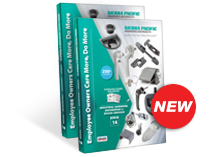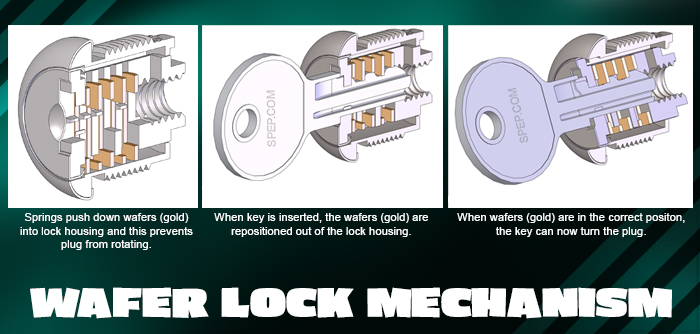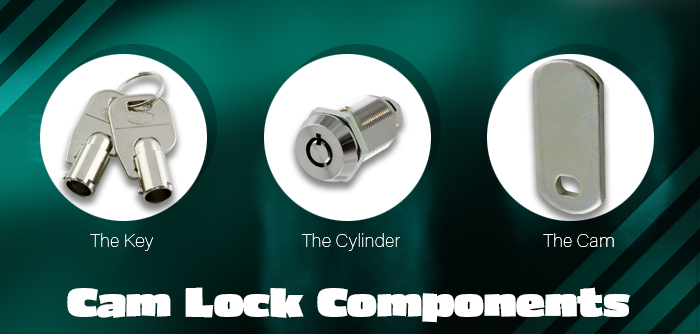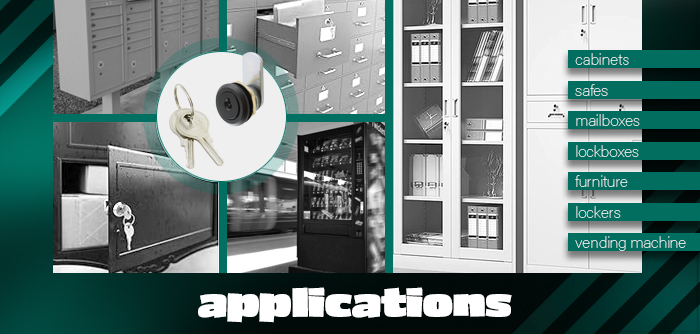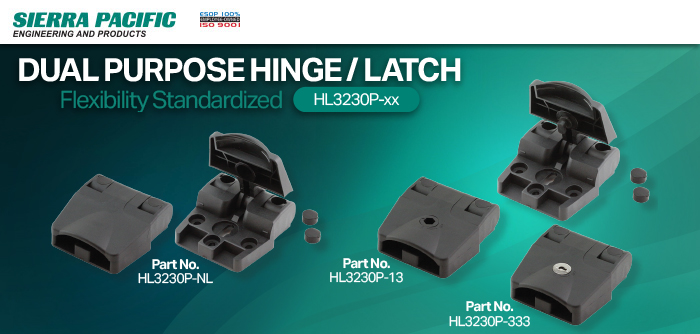
Enclosures housing belongings may be secured for safekeeping using a mechanical lock called a cam lock. These key access control locking systems are often favored over other locks and latches because they secure enclosures without affecting the outward appearance. Discover more about cam locks, including their advantages, applications, and the different components that make them an effective security tool.
What Is a Cam Lock?
If you’re unfamiliar with cam locks, you’ve likely seen one without realizing it. Cam locks are rotational latches which typically operate through use of a bitted key. They can be constructed from different materials, including stainless steel, zinc alloy, aluminum, polypropylene, and brass. They consist of a cylindrical tumbler core and a pawl (also known as a cam) that locks when rotated into place. Cam lock tumblers contain multiple pins, discs, or wafers of different sizes which match up with the appropriate key shaped in the corresponding key code .
Cam locks are installed inside the front of the enclosure but appear mostly flush from the outside. They typically operate with a key for locking and unlocking, but also come in hand operated or tool locking varieties. When a key is inserted, the position of the internal pins or wafers are raised or lowered along the teeth of the key. If the correct key is inserted, those same pins or wafers line up perfectly and allow the core to turn which rotates the cam into the locked or unlocked position.
History of Cam Locks
Various types of locks and latches have been around for thousands of years, with the earliest pin tumbler concepts dating back to ancient Egypt. However, the original double-acting pin tumbler style lock was first patented in 1805 and was then improved upon with the invention of the more modern style cylinder lock in 1848 which is still used today. Even still, cam lock manufacturers like SPEP are continuously innovating, developing, and introducing new functions, as well as drawing on the advantages of other locks to introduce new variations of cam locks that better meet the application demands of consumers.
Types of Cam Locks
There are three main types of tumbler style cam locks, each with limitless applications:
Pin Tumbler Lock
The pin tumbler lock is the original cam lock style. Inside the cylinder, it has pins of various lengths supported by small springs that prevent unlocking unless the user has the correct key. When no key is inserted, the pins remain misaligned so the plug won’t move. When a user inserts the correct key, the gaps between the sets of pins align with the shear line at the edge of the plug. This allows the plug to rotate and unlock.
Wafer Tumbler Lock
Wafer tumbler locks are similar to pin tumbler locks except they use flat wafers instead of pins. These locks offer minimal security due to many common industry-standard key codes, but are easier to manufacture at a low cost versus other types of locks. Most of the cam locks we offer at SPEP are wafer tumbler locks for simple industrial applications.
Disc Tumbler Lock
Disc tumbler locks are often confused with wafer tumbler locks, but they are not the same. Disc tumbler locks are unique because they don’t use springs. Instead, they have slotted rotating detainer discs. When the correct key is inserted, it rotates the discs and aligns the slots. This allows the sidebar to drop and unlock. They are often used for outdoor applications since harsh conditions won’t affect the mechanism.
Cam Lock vs. Cam Latch: What’s the Difference?
Users frequently confuse cam locks and cam latches because both are mechanical devices used to secure doors or panels. This is understandable because they are actually the exact same thing! In many cases, “lock” and “latch” are terms which are often used interchangeably and a “cam lock” is simply a specific type of “cam latch”. A cam latch is any latch which operates by rotating the position of a cam like the hands of a clock. Both latches and locks can be used by themselves to secure doors and panels closed. However, it is most common to use the term “lock” to refer to a latch assembled within another latch.
Quarter-turn latches are an example of another type of cam latch. These function similarly to cam locks except they have a solid plug instead of a hollow tumbler and typically operate by hand or by using a simple tool rather than requiring a key. Cam locks and other types of cam latches are all available in various shapes and styles and mounting options. These simple and cost-effective solutions offer reliable security for a variety of entry point applications.
Different Components of a Cam Lock
The many types of locks may feature different parts, such as gaskets, mounting hardware, adapters, various accessories, and more. These can all add important functionality to any lock, but understanding the basic parts is most essential to understanding how they work. Components include:
The Cam
The cam is the flat, metal piece that rotates to engage or disengage the lock. The cam is attached to the end of the lock cylinder. Although the design of the mechanism is simple, it’s highly effective and economical for securing items.
The Cylinder
The cylinder (also known as the tumbler) is the central element of the locking system. It houses the internal components such as wafers and springs, which interact with the key to allow the cam to rotate and lock or unlock.
The Key
The cam lock’s key is a specially cut piece of metal that fits into the lock cylinder. Each key is coded to a specific shape, ensuring that only the right key balances the pins or wafers correctly to rotate the cylinder and move the cam, thereby securing or unlocking the enclosure.
Advantages of Using Cam Locks
Technological advancements have produced many intelligent locks, which are widely used today. While smart locks are taking over the market, traditional locks, such as cam locks, continue to hold value because of the advantages they provide.
The key advantages of cam locks include:
- Convenience: Cam locks are rather easy to use and install. Requiring only basic tools and no complex configuration, their simplicity makes them an attractive lock option for DIY enthusiasts and professionals alike.
- Low Cost: Simple parts will always be the most economical. Electronic locks will typically be 10x the cost or more than the comparable mechanical option.
- Security: With various designs and security features, cam locks are still the most trusted option to prevent unauthorized access and tampering. Most higher security electronic locks will still require a mechanical override for safety purposes.
- Versatility: Cam locks are incredibly versatile, which is why they meet security needs spanning numerous industries and applications. Simply punch a hole anywhere a lock might be needed and you are ready to install.
Applications of Cam Locks
Cam locks can be used for an array of purposes, including commercial, residential, and industrial applications. As effective anti-theft devices, they are commonly used to secure the following:
- Doors
- Gates
- Cabinets
- Safes
- Mailboxes
- Lockboxes
- Vending machines
- Furniture
- Desks
- Lockers
Find Cam Locks at Sierra Pacific Engineering and Products
Sierra Pacific Engineering and Products (SPEP) is a proud B2B supplier of reliable access hardware that meets the standards of our customers. We offer a wide range of cam locks to help keep your possessions secure. We specialize in custom products and our standard inventory also consists of clamps, hinges, latches, other locks, and more. Contact us today to learn more about how we can help you with your next project.
Editor’s Picks

Sierra Pacific Engineering College Scholarship Program
Feb 7, 2022

What is Supply Chain Management, and Why Is It Important?
Jan 13, 2022
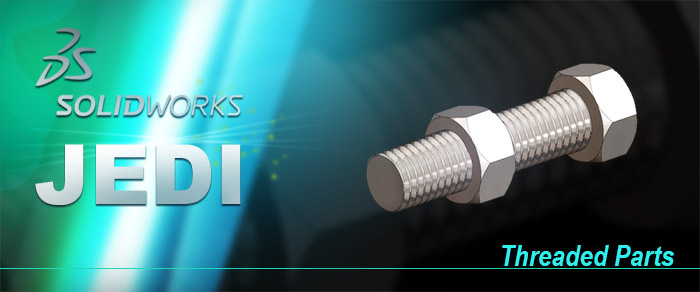
How To Make Threads in Solidworks: Become a Solidworks Expert
Nov 10, 2020
